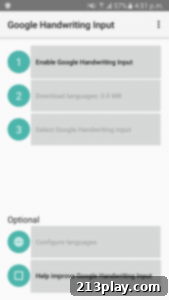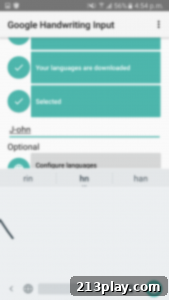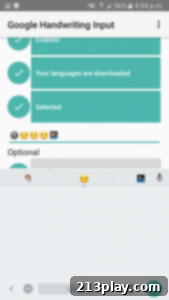Unlock Natural Input: A Comprehensive Review of Google Handwriting Input for Android Devices
In the evolving landscape of mobile technology, input methods are constantly being refined to offer users more intuitive and efficient ways to interact with their devices. Among these innovations, Google LLC presents a unique and powerful tool: “Google Handwriting Input.” This innovative application empowers users to leverage the most natural form of communication—handwriting—directly on their Android phones and tablets, transforming a digital screen into a personal notepad.
This review delves into the functionalities, advantages, and a few minor drawbacks of Google Handwriting Input, providing a detailed perspective for anyone considering this alternative typing method. From its robust language support to its clever emoji recognition, we’ll explore what makes this app a compelling choice for a diverse range of users.

About Google Handwriting Input: A Versatile Digital Pen
Google Handwriting Input functions as an independent input method, effectively acting as a virtual keyboard that replaces traditional tap-typing with the fluidity of handwriting. It’s designed to be a highly versatile tool, catering to a global audience with its impressive capabilities. The app is not just a gimmick; it’s a meticulously developed utility that offers a genuine alternative to standard keyboard input.
Key Features at a Glance
At its core, Google Handwriting Input is engineered for maximum accessibility and expression. It distinguishes itself with several standout features:
- Extensive Language Support: It supports over 100 languages, making it an invaluable tool for multilingual users, language learners, or anyone needing to communicate across different scripts.
- Flexible Writing Styles: Whether you prefer the neatness of printed letters or the flow of cursive, the app handles both with remarkable accuracy. This flexibility extends to the input method itself, accommodating both finger-based writing and stylus use for enhanced precision.
- Rich Emoji Integration: Beyond text, the application intelligently recognizes drawn emojis. This allows users to quickly convey emotions and add personality to their messages by simply sketching common emoji symbols, offering a fun and intuitive way to express themselves.
- Universal Android Compatibility: Designed by Google, it integrates seamlessly across virtually any Android application that requires text input, from messaging apps and email clients to word processors and web browsers.
The concept behind Google Handwriting Input is to bridge the gap between digital convenience and the natural human act of writing, offering a more personal and often more expressive way to interact with your device. It’s particularly useful in situations where a physical keyboard might feel cumbersome or where a more nuanced input method is desired.

Our Experience and In-Depth Review
Having spent considerable time utilizing Google Handwriting Input, our overall experience has been overwhelmingly positive. The app delivers on its promises, offering a surprisingly accurate and intuitive handwriting recognition system. It stands out as a viable alternative for many scenarios, particularly for those who find traditional touch keyboards less natural or for tasks requiring specific character inputs not easily found on a standard layout.
However, like any technology, it presents its unique set of strengths and a few areas where user experience could be refined. We’ve taken note of these aspects to provide a balanced and comprehensive review, highlighting what makes this application excellent and where some challenges might arise for the everyday user.
The Strengths: What Makes it Stand Out
Google Handwriting Input boasts several compelling features that position it as a powerful and beneficial tool for Android users. These strengths contribute significantly to its utility and user satisfaction.
Intuitive Handwriting Recognition
The core functionality of the app—its handwriting recognition—is exceptionally well-engineered. Whether your handwriting is neat or a bit messy, the app demonstrates impressive accuracy in converting written strokes into digital text. This makes it a fantastic option for various tasks, from jotting down quick notes and composing emails to engaging in instant messaging. The system adapts to your writing style over time, becoming even more precise with continued use. This adaptability is crucial for user comfort and efficiency, allowing for a more natural input experience without the constant need for corrections.
Vast Multilingual Support
One of the most remarkable aspects of Google Handwriting Input is its support for over 100 languages. This feature alone makes it indispensable for polyglots, international travelers, or anyone needing to switch between different scripts effortlessly. Imagine being able to write in English, then seamlessly switch to Japanese, Hindi, or Arabic without changing physical keyboards or complex settings. The app identifies the language as you write, or allows for easy manual selection, significantly enhancing communication across linguistic barriers. This level of comprehensive language support is a testament to Google’s commitment to global accessibility and truly sets it apart from many other input methods.
Express Yourself with Emoji Recognition
Beyond textual input, the ability to draw emojis is a delightful and practical feature. Instead of scrolling through endless lists of tiny icons, users can simply sketch a basic representation of an emoji—a smiley face, a heart, or a thumbs-up—and the app intelligently suggests the corresponding digital emoji. This not only speeds up the process of adding flair to messages but also adds a layer of fun and personalization to digital communication. It’s an intuitive way to engage with the visual language of emojis, making your interactions more dynamic and expressive.
Seamless Integration and Accessibility
As a Google product, the Handwriting Input app integrates smoothly within the Android ecosystem. Once enabled, it functions like any other virtual keyboard, accessible from almost any app that requires text input. This universal compatibility means you don’t have to worry about whether a particular application supports it; if you can type there, you can write there. Furthermore, for individuals who may struggle with small keyboard keys or prefer a more free-form input, this app offers a valuable accessibility alternative, potentially reducing typing errors and eye strain.

Addressing the Challenges: Areas for Improvement
While Google Handwriting Input excels in many areas, our review also identified a few aspects that could present minor inconveniences or areas for potential enhancement.
Input Method Switching Fluidity
One notable challenge arises when users need to frequently switch between handwriting input and traditional tap-typing or voice input. The current mechanism for switching input methods on Android devices, while standard, isn’t always as instantaneous or seamlessly integrated as one might hope. This can lead to a slight pause or an extra tap to get back to the preferred method, which might disrupt workflow for users who frequently alternate between typing styles. An ideal improvement would be a more integrated and fluid ‘quick-switch’ button directly within the handwriting interface itself, allowing for instant transitions without navigating through system-level keyboard settings.
Understanding the Privacy Warning
A common concern users might encounter—and one that was highlighted in our observations—is the standard Android warning about enabling third-party keyboards. When Google Handwriting Input is activated, Android issues a generic system message stating that the input method “may be able to collect all the text you type, including personal data like passwords and credit card numbers.” This warning, while a crucial security feature of Android, can be alarming for users unfamiliar with its context.
It’s important to clarify that this is a **standard warning for ALL third-party keyboards** and is not unique to Google Handwriting Input. Android provides this blanket disclaimer because any input method, by its very nature, processes your text. However, Google, as a reputable company, adheres to stringent privacy policies regarding data handling. While the warning is technically true for any keyboard (even Google’s own Gboard processes input for predictive text), Google’s services are built with privacy in mind, and user input data is typically processed on-device or securely in the cloud to improve recognition and provide features like predictive text, without being shared or misused for unrelated purposes. Users should always be cautious about what keyboards they install, but with a Google-developed app, the risk associated with this warning is significantly mitigated compared to lesser-known developers. Nevertheless, a clearer, more context-specific explanation from Google within the app or its setup process might help alleviate user anxiety.
Learning Curve and Niche Application
While intuitive, there can be a slight learning curve involved in getting accustomed to writing on a small screen and trusting the recognition engine. For incredibly fast touch typists, handwriting input might initially feel slower for long passages of text. Its primary strength lies in specific use cases, such as quick notes, unique character input, or when a traditional keyboard feels too cramped. For composing lengthy documents, traditional typing often remains more efficient for many users, positioning Google Handwriting Input as a complementary tool rather than a complete replacement for all input needs.
Who Is Google Handwriting Input For?
This application is particularly well-suited for several types of users:
- Multilingual individuals: Those who frequently switch between languages, especially those with non-Latin scripts.
- Students and note-takers: For quickly jotting down ideas or sketching diagrams that include text.
- Stylus users: Owners of devices like Samsung Galaxy Note series or other tablets with active styluses will find this a natural fit.
- Individuals with accessibility needs: Those who find small keyboard buttons challenging may prefer the larger, free-form input area.
- Users seeking alternative input: Anyone looking to diversify their interaction methods with their mobile device beyond tap-typing and voice.
Final Verdict and Recommendation
Google Handwriting Input stands out as a highly innovative and effective alternative input method for Android devices. Its robust handwriting recognition, extensive language support, and clever emoji drawing capabilities make it a valuable addition to Google’s suite of productivity tools. While the process of switching input methods could be slightly more fluid, and the generic privacy warning requires user understanding, these are minor points against a backdrop of excellent functionality.
If you’re seeking a more natural, expressive, or versatile way to input text on your phone or tablet, especially if you deal with multiple languages or enjoy the precision of a stylus, Google Handwriting Input is highly recommended. It’s a testament to how technology can adapt to human intuition, offering a fresh perspective on digital communication.
| Download Link | Google Handwriting Input on Google Play |
| Price | Free |
| Category | Productivity / Tools |
